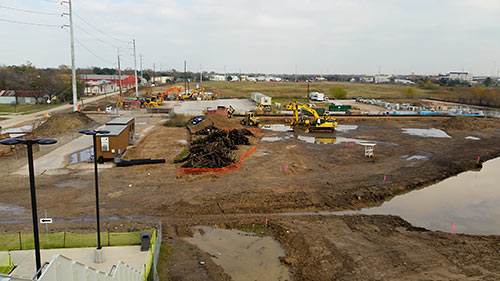
A teaser website is now up and more work is underway on the Residences at Hardy Yards, touted as a component of the Near Northside’s very first mixed-use development. The apartments — “part of a comprehensive, mixed-use redevelopment of the Hardy Rail Yard site,” per city documents — are going in on 5 acres of the long-neglected former Southern Pacific and Union Pacific rail yard near the corner of N. Main St. and Burnett St., 2 blocks north of I-10, hard by the new MetroRail line, and just east of UH-Downtown.Â
Earlier this month City Council approved a performance-based loan of $14,500,000 in federal hurricane relief money to the Houston and Financing Corporation-created entity HY FS LLC to build a 350-residential unit development on part of the 49-acre recently guerrilla-gardened property.
One condition of the loan: that 179 of the total of 350 one- and 2-bedroom units be affordable:
***
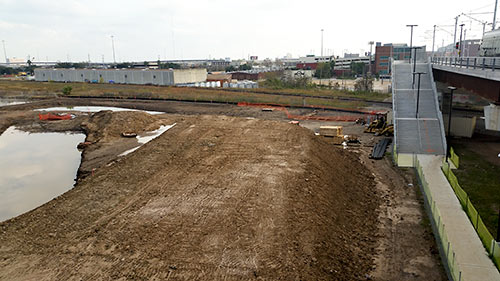
Reads a statement from the project’s backers:
The development, which has a total budget of $50,452,714, will affirmatively further fair housing in the Near Northside by maintaining affordable housing options in a neighborhood where gentrification is expected. Currently there are extensive public and private investments underway in the Near Northside with projects such as the Metro light rail Red Line extension and drainage and street improvements.
One nearby infrastructure enhancement appears to have some bearing on this project: the closure and reconstruction of the nearby Alfred J. Hernandez tunnel, the stated aims of which are to “improve access to Burnett Street from N. Main St.” and “bring major water and wastewater infrastructure improvements to the area.”
Lee Zieben registered the Residences at Hardy Yards website and is listed as the development group principal in city documents. A construction loan of $27,473,993 and developer equity of $8,478,721 comprise the rest of the project’s budget. Amenities planned so far the Residences include “a resident center offering computers and business center.” The lakes you see in the pics are likely temporary.
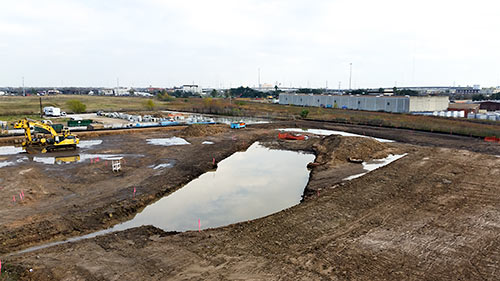
- Residences at Hardy Yards [Houston City Council Agenda]
- Previously on Swamplot: Planting Bush Beans and Citrus Trees at the Hardy Yards
Photos: Swamplot inbox


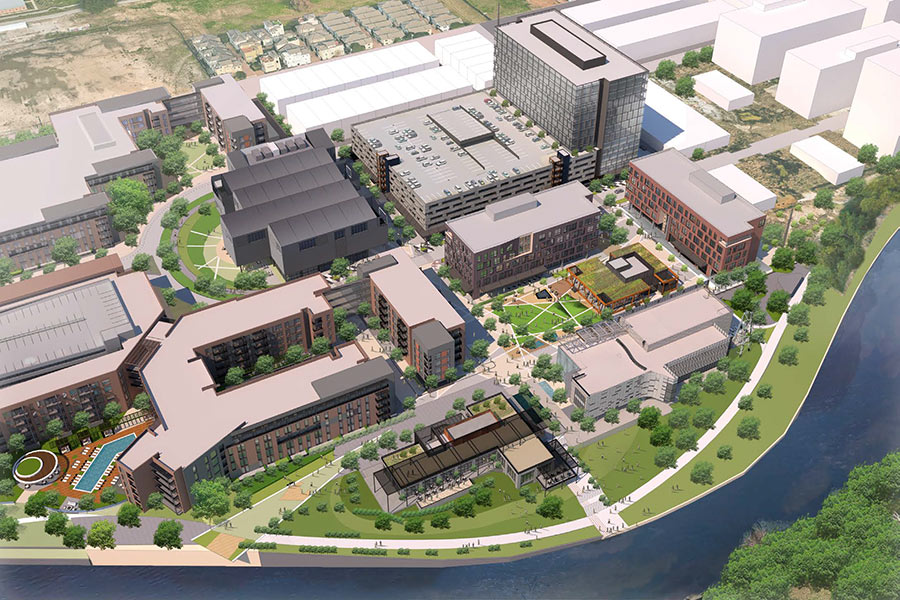
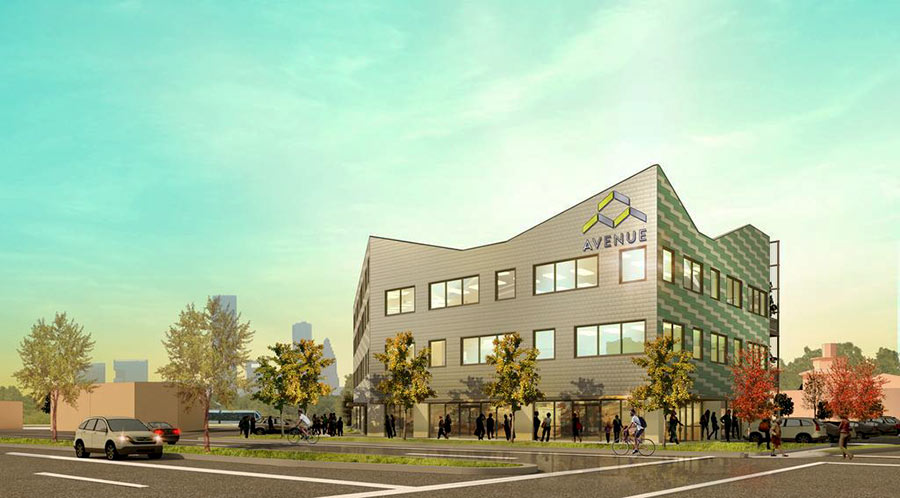
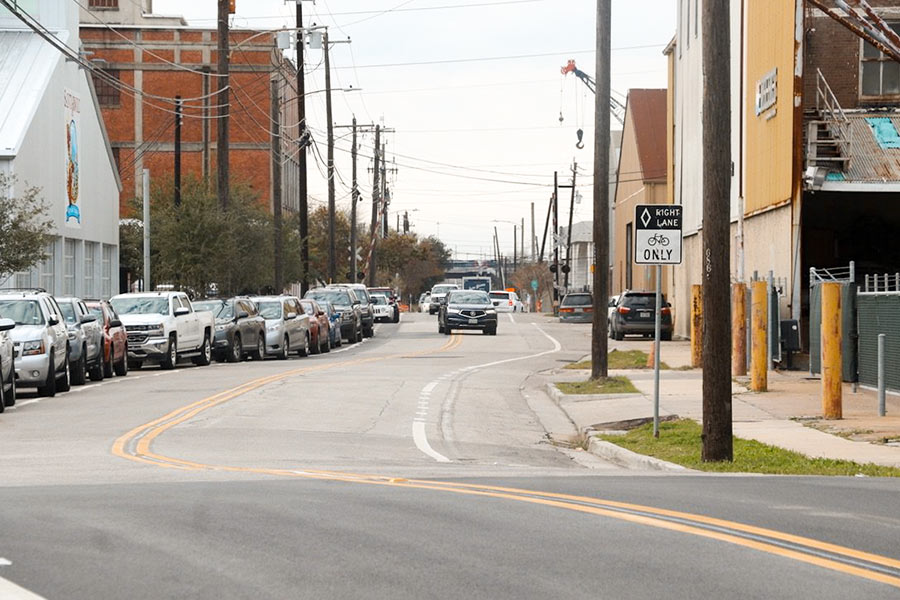
Hmmmm, so I wonder, what will “affordable” be defined as? We shall see…
This is a really important story that will have a huge impact on the Near Northside. There was a huge fight in the mid 2000’s to get Cypress to develop affordable housing on the cite and they refused to do so. TMO lead the fight and qwas able to get the Bill White Administration to commit to building affordable housing in the neighborhood, outside of the Hardy Yards (Chron Story: http://www.chron.com/neighborhood/heights-news/article/Mayor-councilman-sign-housing-deal-for-Near-1570983.php)
.
Many people in the neighborhood were surprised that they applied for affordable housing funds. This site is ~40 acres and this first development will not be the only one. I hope the subsequent buildings will also be affordable and the development will not result in displacing the residents of one of Houston’s oldest neighborhoods.
.
Minor point, the rail yards and this development are is gerrymandered into the 77026 zip code. Thanks for covering this!
Maybe I will have some place to move to when I have to leave Montrose when the 4-plex I am in is finally sold!
Hopefully it will be apartment buildings not the crappy courtyard complexes
The construction you see in the pictures is the transit center where METRO bus routes will connect to the light rail station.
The construction shown in the photos is actually for the Burnett Transit Center, not for an apartment complex.
I, too, wonder about what ‘affordability’ means. Is it something like rent control? Who’s going to administer this? Details, please.
This is decent news for affordable housing advocates, but seems a one-off given the $14.5MM of hurricane relief funds. Also, the affordability period of ten years is relatively short.
Future ghetto / slums.
Usually when I post here, it’s to oppose tax credited low income housing. I’ve seen too many new low income housing projects proposed in suburbs that neither want nor need them, and I’ve seen too many old apartment complexes stuck in endless cycles of neglect. Let me change that here. When it is done right, affordable housing is supported by neighbors, and enhances the neighborhood. And The Residences at Hardy Yard seems to get it right.
.
They’re developing in a neighborhood that is expected to gentrify, so it will lock in affordable housing for whatever the term of the Tax Credits are. I’ve been pushing for this for a long time, since it can prevent the displacement that comes in the end stages of gentrification. They’re developing on an underutilized site, which may not have been redeveloped in the near future without the credits. I’m interested to see if it will help spur new market rate development in the area (my theory is it will). These two benefits are huge – above and beyond just providing more units of affordable housing.
.
It’s not all peaches and cream. The long term viability of The Residences at Hardy Yard will depend on how it’s run. It needs to be owned and managed by people who care, who know what they’re doing, and who aren’t looking to sell the second market conditions are right. Tenants need to be screened, maintenance needs to be done, and security needs to be tight on the premises – even of the real estate market goes bust and the owners aren’t seeing as big profits. I really, really hope they do this at Hardy Yard. If they don’t, the complex will become just another disappointing, run down housing project.
Not knowing precisely what the strings were that came attached to this federal funding or the particulars of the deal, its hard to suggest whether this was money well spent or whether there might have been a better way. But I can say that it does seem to make a lot of sense to place affordable housing near an affordable university near affordable transportation in an area in which any other form of new construction is now unaffordable. It makes some strategic sense.
That being said, there are certainly other parts of the Houston area where Hurricane Ike made a lasting impression that are probably more deserving of the funds. Some suburban enclaves in southeast, northeast, and north Houston had apartment complexes that financially imploded after the storm and it wound up dragging down neighboring properties. If such a thing is feasible, then they really should consider deploying money toward those areas in order to try to bring up such properties to a basic standard. Such a program wouldn’t be flashy. You’d hardly notice a change if you weren’t directly involved in the project or didn’t live right next door long enough to appreciate what has happened (meaning that it may not be politically feasible, even if its the right thing to do), but it would improve more lives more significantly for less money than any new construction project would otherwise be able to. And…there would be some social justice about putting hurricane relief funds back into the neighborhoods that were the most impacted.
“…..will affirmatively further fair housing…. ” really means, “…will artificially further unfair housing…”
Fair always meant no cheating, as in “play fair.” Taking money from the people to force feed other people into in is cheating.
Wasn’t a large part of this area brownfield?
I agree with you, Niche, that there should be a program to bring affordable housing all over Houston up to standard. I would note that Hurricane Ike was just the last nail in the coffin for a lot of our housing. Most of the deterioration came from two decades of neglect, from the market crash of the late 1980s up to Ike.
.
Ike recovery funds aside, Houston is really on it’s own in dealing with deteriorated, affordable housing. The HUD program that would make sense to help with this is their Neighborhood Stabilization Program (NSP), but Houston hasn’t gotten NSP funding since 2009. We could try to make other programs fit, (by adding our own small subsidies to LIHTC to encourage rehab projects) – but HUD and the housing advocates would probably take offense and sue us.
.
Can you see why I get so frustrated about it sometimes?
Yes, easily.
I believe this development is actually planned for the opposite side of the HRY from the rail, not “hard up against” the station. The release of funds document from the City says it’s 5 acres in the southeast corner of a 33.35 acre lot. Though I can’t tell exactly where that is, as there doesn’t appear to be a 33.35 acre parcel there.
To me, when I hear “housing project” i automatically think, low income people on welfare, and what goes with that? Drug dealing and crime.
@Maria Vic Such a gross generalization of people in low income situations. Many people on welfare were actually drug tested in Florida I believe not to many years ago and the legislation to enact that change was highly controversial plus yielded little evidence of high drug use among welfare recipients. Many of these citizens are elderly, low income people/single parents working two or three jobs and the disabled.